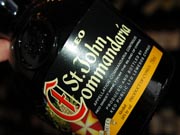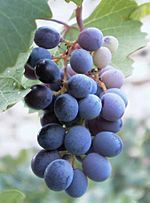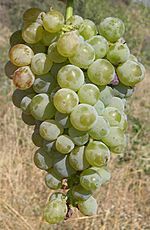Commandaria facts for kids
Commandaria (also called Commanderia) is a special sweet dessert wine from Cyprus. It has a beautiful amber color and is made in the Commandaria region, which is in the foothills of the Troödos Mountains. This unique wine is made from sun-dried grapes called Xynisteri and Mavro. Commandaria is super old! It's known as the world's oldest named wine that is still being made today. Its name, Commandaria, goes all the way back to the crusades in the 12th century.
A Long, Sweet History
This amazing wine has a very long history. People say it dates back to the time of the ancient Greeks, where it was a popular drink at big festivals. The Greek poet Hesiod wrote about a dried grape wine from Cyprus around 800 BC. Later, this wine was sometimes called the Cypriot Manna.
During the crusades, Commandaria was served at a very important wedding in the 12th century. This was the wedding of King Richard the Lionheart to Berengaria of Navarre in the town of Limassol. It's said that King Richard loved the wine so much he called Commandaria "the wine of kings and the king of wines"!
Later, King Richard sold the island of Cyprus to the Knights Templar. These knights kept a large area for themselves near Limassol, which they called "La Grande Commanderie". A Commanderie was like a military headquarters. The word Grande helped tell it apart from two smaller posts on the island.
This area, controlled by the Knights Templar (and later the Knights Hospitaller), became known as Commandaria. When the knights started making lots of this wine to send to royal families in Europe and to give to travelers going to holy lands, the wine took on the name of the region. That's why it's known as the world's oldest named wine still made today!
Over time, Commandaria has been called by a few similar names. In 1863, a book called it Commanderi. In 1879, another book referred to it as Commanderia.
There's a cool story that says in the 13th century, King Philip Augustus of France held the very first wine tasting competition! This event was called The Battle of the Wines. It was written about in a famous French poem from 1224. Wines from all over Europe competed, and a sweet wine from Cyprus, believed to be Commandaria, won!
Another legend says that the Ottoman sultan Selim II invaded Cyprus just because he wanted Commandaria wine! Some also believe that the grapes used for Commandaria were sent to Portugal and became famous as the grapes for port wine.
How Commandaria is Made
Commandaria is made only from two special types of grapes that grow in Cyprus: Xynisteri and Mavro. The grapes are left on the vine until they are very ripe and full of sugar. Once they are picked, they are laid out in the sun. This helps even more water evaporate, making the grapes super sweet and concentrated.
After drying, the grapes are crushed to get their juice. This juice then ferments. Fermentation is when the sugar turns into alcohol. Because the grapes are so sweet, the wine naturally reaches a high alcohol level, usually around 15%.
This whole process must happen in one of 14 special villages in the Commandaria Region. After fermentation, Commandaria must be aged for at least two years in Oak Barrels. This aging can happen outside the 14 villages, but it's still carefully watched.
Sometimes, after fermentation, a little extra grape alcohol is added to the wine. This makes sure the wine has at least 15% alcohol. However, adding extra alcohol is not always necessary.
The way Commandaria is made is very old. The Greek poet Hesiod described a similar method around 700 BC. He wrote about leaving grapes in the sun for ten nights, then in the shade for five more days before making wine. Pliny the Elder also wrote about Greeks drying grapes in the sun on hurdles.
In 1879, a traveler named Samuel Baker described how the grapes were dried on the flat roofs of houses until they started to shrivel. He thought this method was used because farmers wanted to protect their grapes from being stolen or eaten by animals in the vineyards.
Today, Commandaria is made by large wine companies like KEO, ETKO, LOEL, and SODAP. Many smaller, modern wineries are also making high-quality Commandaria.
In the late 1800s, Cyprus produced a lot of Commandaria, about 385,000 liters each year. Much of this wine was sent to other countries, especially Austria. Today, the production of Commandaria continues to grow, and a lot of it is still exported around the world.
Official Rules for Commandaria
Commandaria has a special label called a protected designation of origin (PDO) in places like the European Union, the United States, and Canada. This means that for a wine to be called Commandaria, it must follow strict rules and come from a specific place.
By law in Cyprus, Commandaria can only be made in 14 nearby villages. These villages are: Agios Georgios, Agios Konstantinos, Agios Mamas, Agios Pavlos, Apsiou, Gerasa, Doros, Zoopigi, Kalo Chorio, Kapilio, Laneia, Louvaras, Monagri and Silikou. This area is known as the Commandaria Region. It's located on the south side of the Troödos Mountains, about 500 to 900 meters high.
Only grapes from vineyards that are at least four years old can be used. The way the vines are grown is also specific, and watering them is not allowed. Grapes can only be harvested after the Cyprus Vine Products Commission gives permission. This permission is based on how much sugar is in the grapes. Xynisteri grapes must have at least 212 grams of sugar per liter, and Mavro grapes must have 258 grams per liter or more. After harvesting, the grapes are laid in the sun for about 7–10 days to increase their sugar concentration even more, to a specific level.
In 2006, the Wine Products Association of Cyprus even chose an official Commandaria wine glass, made by an Austrian company called Riedel.
See also
 In Spanish: Commandaria para niños
In Spanish: Commandaria para niños





